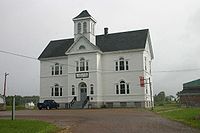
Great Village, Nova Scotia
Encyclopedia

Cobequid Bay
Cobequid Bay is an inlet of the Bay of Fundy and the easternmost part of the Minas Basin, located in the Canadian province of Nova Scotia. The bay was carved by rivers flowing into the eastern end of the Bay of Fundy....
in Colchester County
Colchester County, Nova Scotia
Colchester County is a county in the Canadian province of Nova Scotia.-History:The appellation Colchester was applied in 1780 to the district previously called "Cobequid," and was derived from the town of Colchester in Essex...
Nova Scotia
Nova Scotia
Nova Scotia is one of Canada's three Maritime provinces and is the most populous province in Atlantic Canada. The name of the province is Latin for "New Scotland," but "Nova Scotia" is the recognized, English-language name of the province. The provincial capital is Halifax. Nova Scotia is the...
. It is considered locally to incorporate the areas of Highland Village to the west and Scrabble Hill to the north northwest.
Settlement
What was to become Great Village was first settled by French-speaking Acadians around 1630, who built dykes in the marshes, reclaimed land, and created a village called "Petit-Louis" or "Vil de Cadets". They were expelled, along with the rest of the Acadian population of Nova Scotia, by Governor Lawrence in 1755. This event, known as the Expulsion of the Acadians, saw the Acadians dispersed among the American colonies, Louisiana, England and France. They left behind memorials in the names of nearby rivers (anglicised in modern times into Portaupique and Debert).The next settlers, whose descendants were to remain, came in the spring of 1762: Protestants of predominantly Ulster
Ulster
Ulster is one of the four provinces of Ireland, located in the north of the island. In ancient Ireland, it was one of the fifths ruled by a "king of over-kings" . Following the Norman invasion of Ireland, the ancient kingdoms were shired into a number of counties for administrative and judicial...
origins, brought over by formerly-Nova-Scotia-stationed and by then former-British-army-Captain Alexander McNutt, himself an Ulsterman. Many of these settlers re-used the burnt-out storage cellars of the expelled Acadians as the foundations for their first homes.
"The vessel 'Hopewell' reached Halifax carrying Irish settlers on October 9, 1761, and landed passengers where they remained over the winter. Early next spring arrangements were made to hire a vessel to take these people to the 'District of Cobequid' where the best lands and greatest quantities of marsh in that part of the country were assigned to them, and furnished them with provisions out of the Provincial Funds. Many of these settlers took up land in what is now Londonderry district. Tradition is that twenty families located along the Bay Shore between Isgonish River and Bass River."
The original grants of land of the Township of Londonderry were prepared in 1765, but because of the British government's explicit prohibition against the granting of Nova Scotia land to Irish, they were not made official until February 10, 1775.
"The reader should bear in mind that the settlement of the township of Londonderry was for the most part on those lands near the Bay Shore--Masstown, Glenholme, Great Village, Portaupique, and Bass River. The present community of Londonderry, or Acadia Mines, was not included in the Area described in the Grant of 1775. Presumably settlement of that community did not commence until iron ore was discovered there in 1847."
The Acadian
Acadian
The Acadians are the descendants of the 17th-century French colonists who settled in Acadia . Acadia was a colony of New France...
settlers built dykes to create farmland from the area's saltmarsh. The village partially exists on this created land, which is still farmed. The dyked land, substantially below the inhabited portion of Great Village, is an unspoiled heritage-engineering site worthy of note.
"In the early nineteenth century this village was called 'The Port of Londonderry' and was a Port of Registry." Several shipyards thrived in the late 19th century and along with lumber exports created the wealth which built many of the fine, large Victorian-period houses and gardens visible today around the village. Shipbuilding culiminated in the 1885s with the construction of the four masted barque John M. Blaikie, which along with the barque Kings County
Kings County (barque)
Kings County was a four masted barque built in 1890 at Kingsport, Nova Scotia on the Minas Basin. She was named to commemorate Kings County, Nova Scotia and represented the peak of the county's shipbuilding era...
built across the Minas Basin, was one of only two four masted barques ever built in Canada and among the largest wooden sailing vessels built in Canada.
Literary significance
In her youth, the Pulitzer PrizePulitzer Prize
The Pulitzer Prize is a U.S. award for achievements in newspaper and online journalism, literature and musical composition. It was established by American publisher Joseph Pulitzer and is administered by Columbia University in New York City...
-winning author Elizabeth Bishop
Elizabeth Bishop
Elizabeth Bishop was an American poet and short-story writer. She was the Poet Laureate of the United States from 1949 to 1950, a Pulitzer Prize winner in 1956 and a National Book Award Winner for Poetry in 1970. Elizabeth Bishop House is an artists' retreat in Great Village, Nova Scotia...
lived with her grandparents, William Brown Bulmer and Elizabeth (Hutchinson) Bulmer, in Great Village. The Bulmer House, also known as the Elizabeth Bishop House
Elizabeth Bishop House
The Elizabeth Bishop House, also known as the Bulmer House, is an historic single-family house that today is used as an artists' retreat in Great Village, Nova Scotia. The house is associated with Pulitzer Prize winning author Elizabeth Bishop who in her youth lived in the house each summer with...
is an artists' retreat and is a Nova Scotia Provincially Recognized Heritage Site. Elizabth Bishop based many of her stories on the life of a fictional village of the same name. One story is called appropriately, "In the Village".

